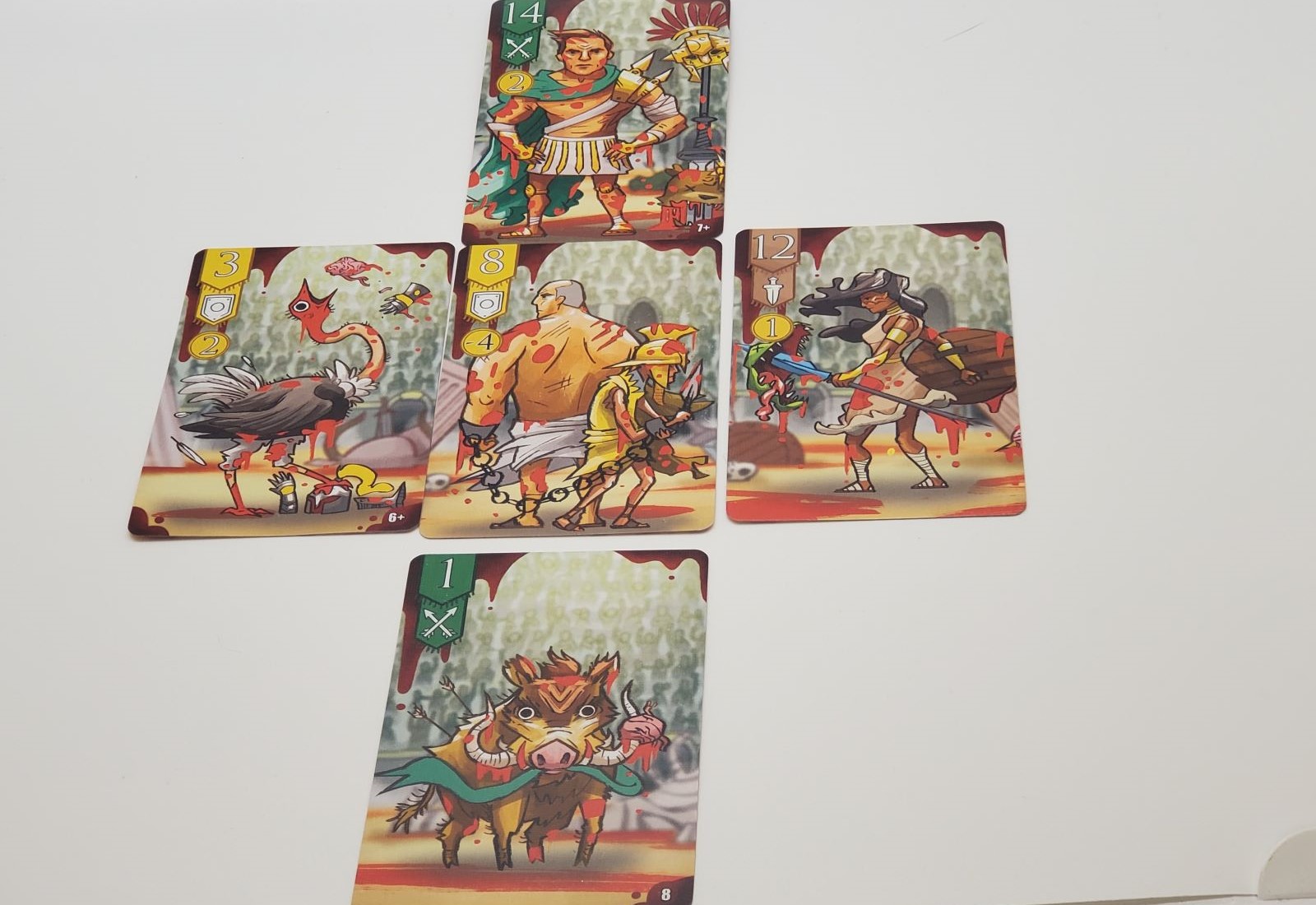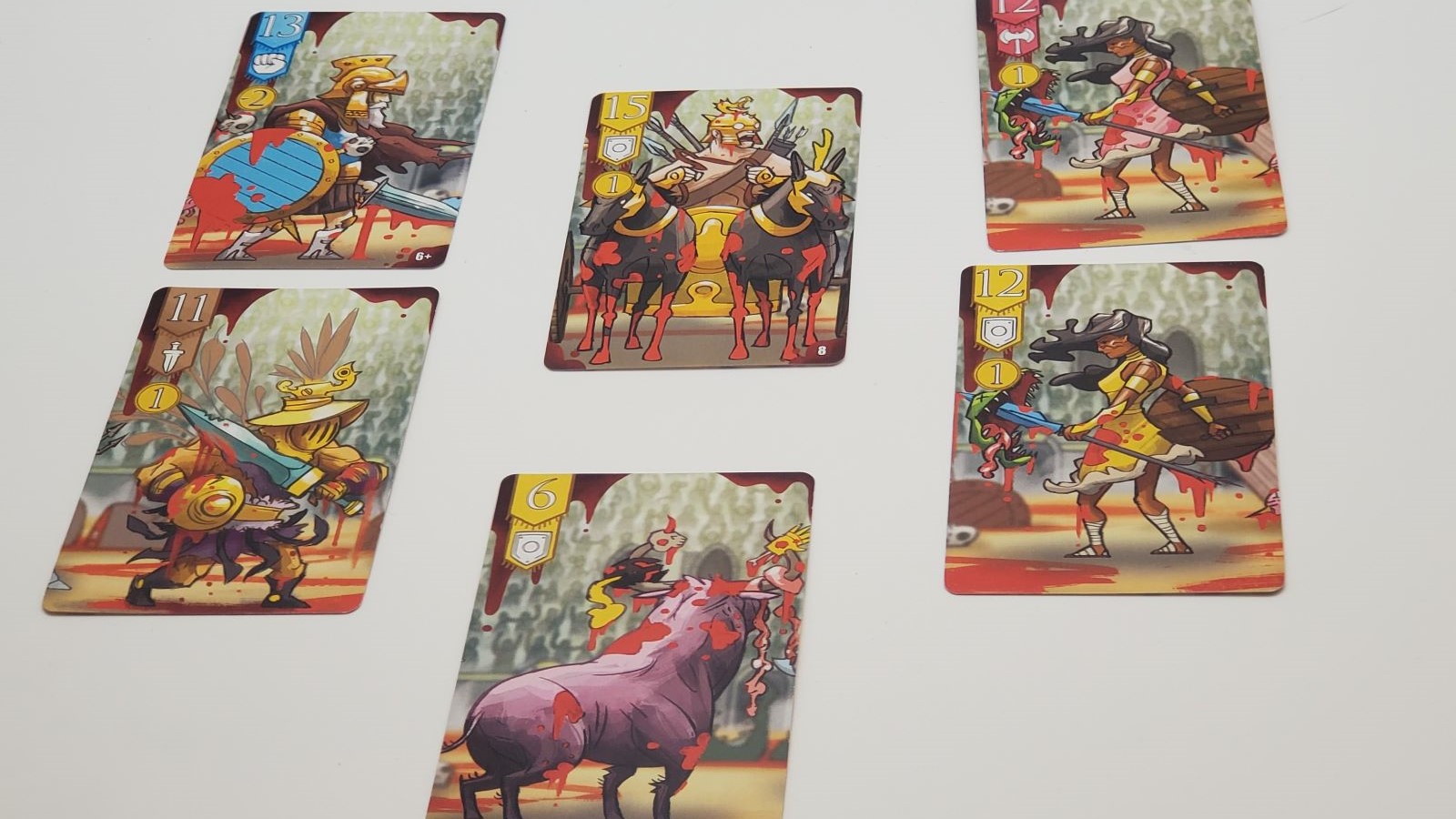
For Card Sharps
Gorus Maximus is a trick-taking game for 1-8 players. Yes, points are a good thing. No, you can’t shoot the moon. Yes, there’s a trump suite. Initially, it matches the leading card in a round but it can change to a different suite if someone follows with a card of the same rank, different suite. The first to achieve a round’s top score three times wins. At first blush, the shifting trump seems to be Maximus’ gimmick, but its true appeal lies in seating 6-8. It’s fun and balanced, yet chaotic enough to frustrate players who prefer to plan ahead. End of review.

For Everyone Else
Okay, maybe that’s not a full-service review, but to anybody versed in the cant of trick-taking that one paragraph will do the job of ten. Jargon grows like weeds around old games, and trick-taking’s covered in them.
Now that the veterans have gotten what they need, I’d like to focus on the uninitiated and the curious. Those seem to be the people that Gorus Maximus wants.
Trick-taking is one of the oldest and most inflexible gaming forms in the world. Each player starts with an equal portion of a deck of cards, then whittles that hand down to zero, usually playing one card at a time. The first player in a round chooses by example the suite others can play (“leads”)—they play an ace of spades and the table must “follow suite” if they can, though they can ignore that if they can’t. The strongest card (depends on the game, but usually the highest card of the leading suite) will claim the others (“take the trick”) and move them to a scoring pile.
Then the claimant leads the next round. Scoring and the number of times players repeat this process vary by game. In Bridge, for instance, you wager how many tricks you can win and must hit that number exactly. Regardless, the genre’s strategy pivots around programming your hand, knowing when to seize the lead, and knowing when to hand it over. In a sense, it tickles the same part of the brain that enjoys Robo Rally, Space Alert, and Mechs vs. Minions.

Those games, however, don’t rely on the arcane skill of counting cards. To play an old-school trick-taker intelligently, you have to intuit how a 52 card deck splits and notice when players run out of a suit. People’s talent for card counting varies so wildly that this creates a problem: the only worthwhile matches are between equally skilled opponents.
It’s not uncommon for a Bridge fiend to lay down their cards, show the math behind their inevitable victory, and call for the next set. A card sharp will shrug, admit defeat, and shuffle up the deck. Good hands happen. A novice who can’t discern the math feels cheated and impotent. Imagine playing chess against a grandmaster and hearing, “Checkmate in ten moves.”
Besides the gory, adults-only art by Kwanchai Moriya, Gorus Maximus’ sole contribution to the formula is fog in the metaphorical crystal ball. Play a card of the same number, different color as the last one and the active suite now changes to that color. Ever played UNO? What gives? Why would a game add luck and nothing else?
Because, like Star Wars fans, veterans of trick-taking overestimate the reach of the brand and underestimate its thickets of jargon. Acquaintance with trick-taking’s logic and rhythm starts early with family nights of Euchre or Hearts. As a result, the designer market makes Tournament at Camelot or Skull King, which really addresses fans even if the rulebook imagines that it’s addressing a layman.
Gorus Maximus’ layman isn’t imaginary. This allows them to learn from and catch up to advanced players. Its large player count and its UNO mechanism may frustrate a master. Nevertheless, those same attributes open the door to new combatants who may, with practice, reach the fields of a game like Camelot. For the future of this medium, that’s a valuable commodity, indeed.
Further Reading
Regarding luck’s ability to level playing fields, the legendary creator of Magic: the Gathering, Richard Garfield, gave an excellent lecture you can watch here.

Gorus Maximus
Good
Gorus Maximus services an oft-overlooked part of the community while providing a light atmosphere. If a group has wildly uneven experience with trick-taking games, this is a good way to smooth things over.
Pros
- Colorful art
- A good school for card warriors
- Excellent for parties
Cons
- Heavily formulaic
- Not child friendly
- May be too chaotic for genre veterans
